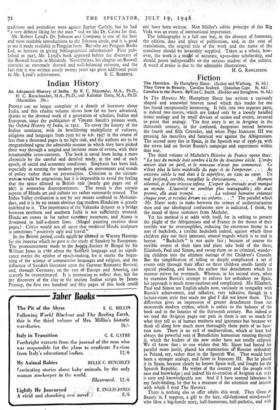Indian History
PEOPLE can no longer complain of a dearth of literature about India, and this efudite volume shows how far we have advanced, thanks to the devoted work of a generation of scholars, Indian and European, since the publication of Vincent Smith's pioneer work, the Oxford History of India, in 1912. To cover the history of the Indian continent, with its bewildering multiplicity of cultures, religions and languages from 2500 B.0 to A.D. 1937 in the course of less than a thousand pages is no light task, and the authors are to be congratulated upon the admirable manner in which they have picked their way through a tangled and intricate maze of events, with their innumerable cross-currents. The book is saved from being a mere chronicle by the careful and detailed study, at the end of each epoch, of social and economic conditions. Emphasis has been laid, especially in treating the modern peric4 on movements and trends of policy rather than on personalities. Criticism in the circum- stances would be ungracious, but it is impossible to avoid the feeling that the space allotted to British rule (nearly 400 pages out of 967) is somewhat disproportionate. The result is that certain aspects of Hindu art and culture are rather summarily treated. The Indus Valley civilisation is not by any means confined to Mohenjo- dars, and it is by no means obvious that modern Hinduism is greatly indebted to it. The importance of the Vakataka dynasty as a bridge between northern and southern India- is not sufficiently stressed. Hindu art comes in for rather sums Lary treatment, and Ajanta is dismissed in half-a-dozen lines. (Mogul painting receives three pages.) Critics would not all agree that medieval Hindu sculpture is sometimes " positively ugly and horrid.", In the British period, credit nlight be- alleekeil to Warren Hastings fo: the impetus which he gave to the study of Sanskrit by Europeans. The pronouncement made to the 4stitNtSociety Of Bengal by Sir William Jones in 1786 about the Sarigkrif language and its signifi- cance merits the epithet of epoch-making, for it marks the begin- ning of the science of comparative languages and religion, and the influence of Sanskrit literature upon the German Romantic Revival, and, through !Germany, on the rest tifoEurope and Americ can scarcely be overestimated. It is interesting to reflect that, but for the discovery of the clue to the-ancient Indian scripts by James Prinsep, the first two hundred and fifty pages of this book could not have been written. Max Miillees editio princeps of the Rig Veda was an event of international importance.
The bibliography is a full one but, in the absence of footnotes, the edition, date and place of publication, and, in the case of translations, the original title of the work and the name of the translator should be invariably supplied. Taken as a whole, how- ever, the work is a mol of accurate, up-to-date scholarship, and should prove indispensifile to-the serious student of the subject. A word of praise is due to the admirable illustrations.
H. G. RAWLINSON.


























 Previous page
Previous page